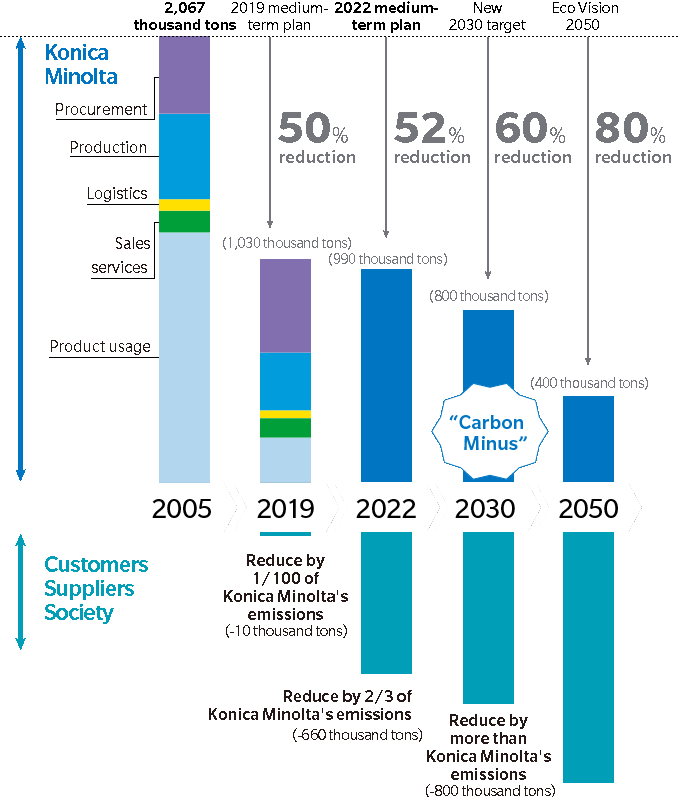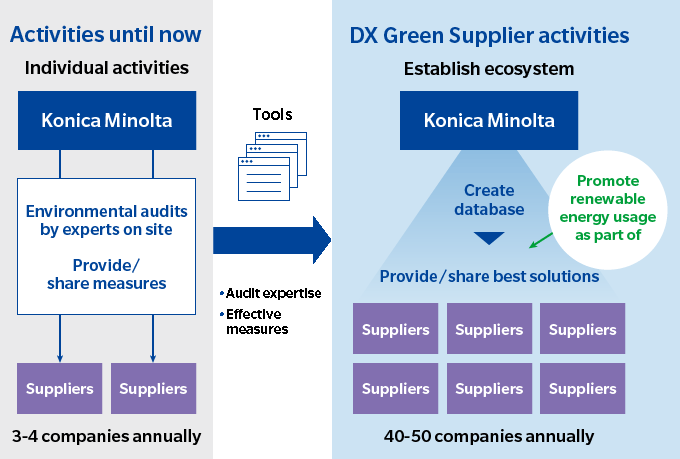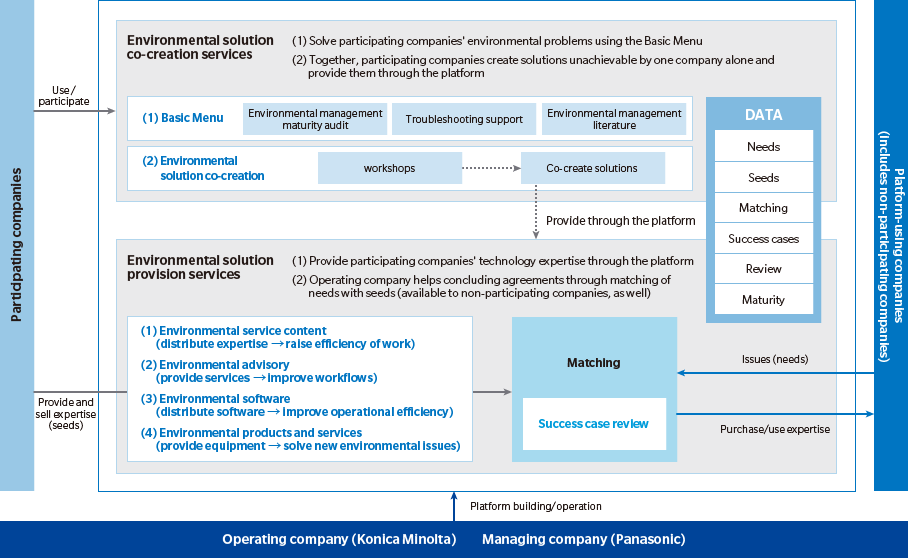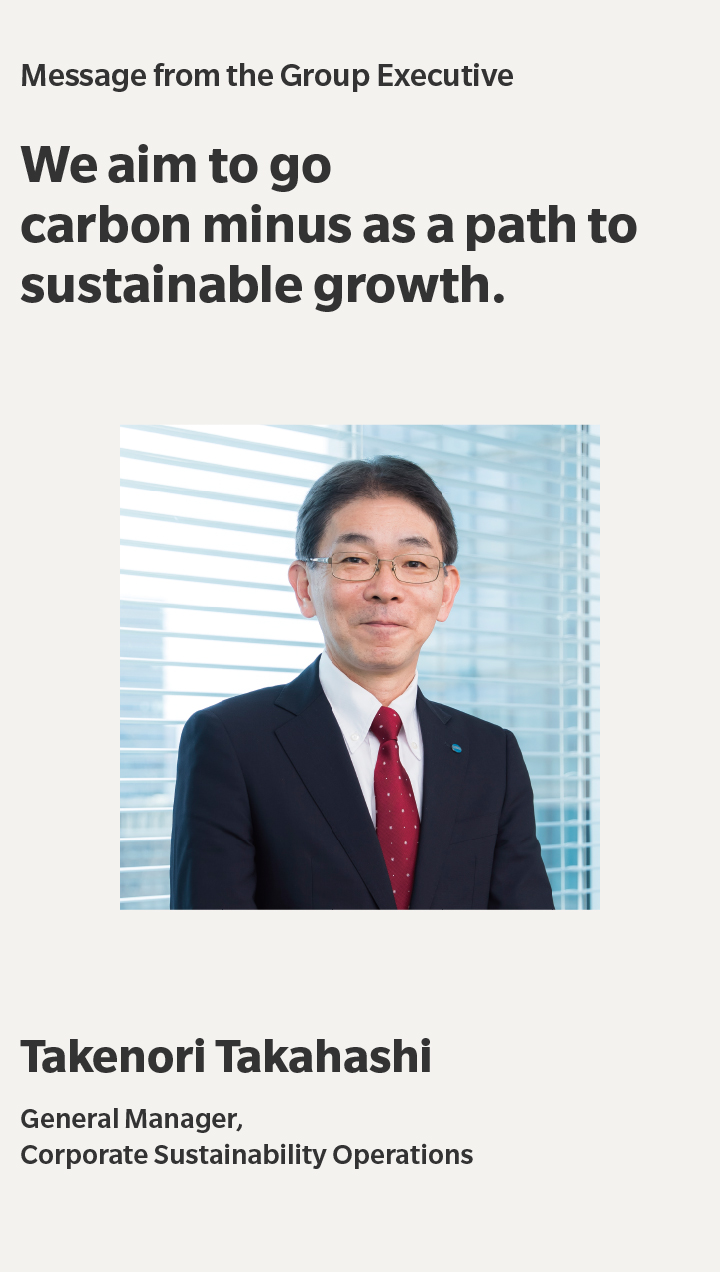Seeking to be carbon minus by 2030
Climate change and other environmental problems are drawing increasing concern as an issue that impacts corporate sustainability. In 2009, Konica Minolta formulated the Eco Vision 2050 long-term environment plan, which looks forward to 2050. Since then, we have been preparing for future risks from environmental problems and have been undertaking environmental activities under the theme of achieving business growth by solving environmental issues.
In 2017, we took a step forward when we established a new goal in the form of Eco Vision 2050, which aims to see us become carbon minus by 2050. “Carbon Minus” means reducing our CO2 emissions by 80% compared to fiscal 2005 over the lifecycle of Konica Minolta’s products, and it will require providing support for environmental problem-solving to our customers and suppliers to reduce CO2 emissions to the extent that our product lifecycles are not affected. In reducing CO2 emissions beyond the emissions for which we ourselves are responsible, we aim to become carbon minus.
In fiscal 2020, at the same time that we drafted our long-term management vision, which looks forward to 2030, and the DX2022 medium-term business strategy, we made the decision to push forward our timeline for achieving carbon minus status to 2030. This was prompted by an achievement we made during the previous medium-term business plan. Fiscal 2019 saw us reduce CO2 emissions by 50% compared to 2005 throughout the entire lifecycle of our products. In conjunction with the reduction of CO2 emissions and resource usage, we also reduced energy and resource costs by approximately ¥1.8 billion over three years. Furthermore, we saw an increase in product and service sales owing to our green marketing activities, through which we provide customers with our environmental expertise. These factors increased our top line by ¥780 million in fiscal 2019. We see this outcome as having succeeded in achieving increased profits through our efforts to address environmental issues during the period of the previous medium-term business plan.
Based on this achievement, by accelerating efforts to reduce CO2 emissions, we will now focus on promoting business growth and meeting our challenging goal of becoming carbon minus by 2030. We will do this by building an environmental ecosystem for coordinating with many companies through the use of our digital technologies.
Moving the carbon minus goalpost up to 2030

Further reducing our environmental footprint through DX
Beginning in fiscal 2020, we will utilize DX to enhance coordination with more customers and suppliers in order to further reduce our environmental footprint.
One such effort is the digitalization of our “green supplier activities,” through which we provide our suppliers with our environmental expertise. Over the years, Konica Minolta experts have visited our suppliers’ factories and provided support in conducting energy audits and executing plans. We have now digitized and automated our expertise and developed a system that suppliers can use to conduct self-audits and execute plans. With this, we expect to be able to dramatically broaden the range of those benefiting from these activities, while further reducing our environmental impact and costs.
DX Green Supplier activities

Another new initiative is the Environmental Digital Platform we launched in June 2020. This is an ecosystem that will improve environmental management efficiency by enabling Konica Minolta and participating companies to share knowledge and expertise and create new value together. Panasonic Corporation, a company with extensive expertise and global solutions, provides support as the managing company, with Konica Minolta in charge of operations. We began with 15 participating companies, and will expand the circle of cocreation by gradually bringing in more.
This platform consists of “solution co-creation opportunities,” which involve participating companies pooling their technologies and expertise to create new solutions for problems difficult for individual companies to solve on their own, and “solution provision opportunities,” which involve sharing and utilizing the environmental technologies and expertise that participating companies have developed through years of practice.
Through these two types of opportunities, we will solve environmental problems more quickly through inter-company coordination, speed up efforts to achieve innovation through co-creation, and contribute to environmental problem-solving at a global scale.
Over the three-year period of DX2022, we will achieve sustainable corporate growth by launching cooperative efforts such as these with many companies, through which we will significantly reduce our environmental footprint and contribute to a stronger bottom line.
Environmental Digital Platform





